

2016 March 12
This infrared view (click to enlarge) from the Spitzer Space Telescope team reveals the cosmic background when the universe was less than one billion years old. The light probably originated from the universe's very first groups of objects - huge stars or voracious black holes. In this image darker shades correspond to dimmer parts of the background glow, while yellow and white show the brightest light. The image was created from Spitzer data that was processed to mask out stars, galaxies and other sources. The Spitzer mission is managed for NASA by JPL in Pasadena, Calif. Image courtesy NASA/JPL-Caltech/A. Kashlinsky (GSFC)
(DEC 30) Occurring just days after the start of the new year, the Quadrantid meteor shower typically produces several meteors per hour. The annual shower is predicted to peak January 3 at 17:00 PST (January 4 at 01:00 UTC). However, in 2007 the shower coincides with the full Moon, seriously hampering the display for visual observers.
(DEC 28) The unexpected longevity of NASA's Mars rovers Spirit and Opportunity is giving the agency an opportunity to test new capabilities useful to these missions and future rovers. More
Streamers of snow streak from the Great Lakes in this Terra satellite MODIS instrument image (click to enlarge) taken on December 9. The white swath extending from Lake Michigan to the lower left was deposited by a powerful storm that left thousands without power for many days. The snow on the southeastern side of the Great Lakes fell as lake-effect snow when icy winds blew across the lakes, picked up the relatively warm, moist air, and pushed it over the colder land, where it condensed into snow. The MODIS instrument was built by Santa Barbara Remote sensing in Goleta, California. Image and caption courtesy MODIS Land Rapid Response Team, NASA GSFC
(DEC 20) NASA data from earth observation satellites is helping build the capability to determine when and where wildfires may occur by providing details on plant conditions, according to a recent study. More
(DEC 20) VANDENBERG AIR FORCE BASE, Calif. - 30th Space Wing officials will meet an inspection team from the Russian Federation today. The team is here to conduct an on-site verification of compliance with the Strategic Arms Reduction Treaty.
The United States sends similar teams to inspect former Soviet strategic weapon facilities. The reciprocal inspections are an element of the START I accord which was signed in 1991 and went into force in 1994. The current accord is first in a series, the only one ratified, with target arms reduction numbers tied to future calendar years.
Vandenberg AFB news release
(DEC 18) New observations from NASA's Spitzer Space Telescope strongly suggest that infrared light detected in a prior study originated from clumps of the very first objects of the universe. The recent data indicate this patchy light is splattered across the entire sky and comes from clusters of bright, monstrous objects more than 13 billion light-years away. More
A Delta II rocket climbs into orbit following lift-off from Vandenberg AFB on December 14. The Boeing booster was carrying NROL-21, a classified payload belonging to the Chantilly, Virginia-based National Reconnaissance Office. Aerospace photographer Brian Lockett took this image near Refugio Pass in Santa Barbara County. Copyright 2006, Brian Lockett. Used with permission.
(DEC 14) VANDENBERG AFB, Calif. - A Delta II rocket carrying a National Reconnaissance Office payload from Space Launch Complex-2 on North Vandenberg at 1 p.m. today.
The spacelift commander for this mission was Col. Jack Weinstein, 30th Space Wing commander.
"Today's successful launch was accomplished from the outstanding teamwork from all organizations to include the 30th Space Wing, Space and Missile Systems Center, NRO, and recently named United Launch Alliance," said Col Weinstein. "Vandenberg ensures national security with each executed launch, continuously proving that no one does it better."
The 30th Space Wing is the Air Force Space Command organization responsible for all Department of Defense space and missile launch activities on the West Coast of the United States.
Vandenberg AFB news release
(DEC 13) Early radar and imaging results from NASA's Mars Reconnaissance Orbiter show details in martian polar layers that will yield information about recent climate cycles on the red planet. More
This close-up of a HiRISE camera image (click to enlarge) from NASA's Mars Reconnaissance Orbiter shows the current location of the Spirit Mars rover. Toward the top of the image is "Home Plate," a plateau of layered rocks that Spirit explored during the early part of its third year on Mars. Spirit itself is southeast of Home Plate. Also visible are the tracks made by the rover before it arrived at its current location. HiRISE is operated by the University of Arizona and was built by Ball Aerospace and Technology Corp., Boulder, Colo. Image courtesy NASA/JPL-Caltech/University of Arizona.
(DEC 5) A NASA satellite designed to study how microbes respond to spaceflight is scheduled to lift-off from Wallops Island, Virginia next week. The 10-pound spacecraft is a cooperative effort of the Ames Research Center and several California universities. More
(NOV 28) Mark your calendar. On Dec. 8th through 11th, Jupiter, Mercury and Mars will form a tight triangle in the eastern sky at dawn. All three will fit together in the field of view of ordinary binoculars. (Mars is dim enough that binoculars may be required to see it.) Of special note is the morning of Dec. 10th when Jupiter and Mercury converge within 0.25 degrees of one another. The close, bright pair will be visible to the unaided eye--a fabulous sight in the rosy glow of sunrise.
Courtesy www.spaceweather.com
This recently released composite image (click to enlarge) combines views from three NASA spacecraft to show extensive detail in N49, a supernova remnant in the Large Magellanic Cloud. The Chandra X-ray view (blue) shows million-degree gas in the center. Much cooler gas at the outer parts of the remnant is seen in the infrared image from the Spitzer Space Telescope (red). The unique filamentary structure seen in the optical image by Hubble (white and yellow) has long set N49 apart from other well understood supernova remnants. The Spitzer is managed for NASA by JPL in Pasadena. Image courtesy of NASA/JPL-Caltech
(NOV 30) TUCSON, AZ - The forecast for the Geminid meteor shower this year is excellent due to the lack of moonlight. Often considered by many astronomers to be the best meteor shower of the year, it's expected that worldwide 30 to 60 (or more) shooting stars per hour will flash across the sky Wednesday night Dec. 13-14, weather permitting. More
(NOV 29) The University of Arizona-based team that operates the high-resolution camera on NASA's Mars Reconnaissance Orbiter, in conjunction with NASA, is releasing the first of what will be a non-stop flood of incredibly detailed Mars images taken during the spacecraft's two-year primary science mission. More
Nearly six years after its launch from California, NASA's Terra satellite continues to provide impressive images of the Earth such as this view (click to enlarge) of South America's southern tip. Visible in this three-spectral band image are Tierra del Fuego, Argentina, and Chile. Image courtesy Jeff Schmaltz, MODIS Land Rapid Response Team, NASA GSFC
(NOV 21) Pasadena, Calif. - NASA's Mars Global Surveyor has likely finished its operating career. The spacecraft has served the longest and been the most productive of any mission ever sent to the red planet. More
(NOV 20) SANTA CRUZ, CA -- Researchers at the University of California, Santa Cruz, have used NASA's most powerful supercomputer to run the largest simulation to date of the formation and evolution of the dark matter halo that envelopes the Milky Way galaxy. Their results show substructures within the halo in unprecedented detail, providing a valuable tool for understanding the evolutionary history of our galaxy. More
The webmaster photographed the Iridium 84 satellite (click image to enlarge) as it briefly flared in brightness while crossing the sky above southern California last Friday evening. Iridium series spacecraft have mirror-like surfaces that catch the Sun's rays, causing brief, but tremendous increases in the satellites' brightness called "Iridium flares". Iridium 84 was launched in 1998 from Vandenberg AFB. Copyright 2006, Brian Webb
(NOV 17) PROMONTORY, Utah - NASA's Space Shuttle Program successfully fired a reusable solid rocket motor Thursday, Nov. 16, at a Utah facility. The two-minute test provided important information for nighttime shuttle launches and for the development of the rocket that will carry the next human spacecraft to the moon. More
(NOV 14) WAUKESHA, WI - This Saturday night, the annual Leonid meteor shower could put on a good show. The meteor shower is active November 14-21, but astronomers expect heightened activity from about 11:45 p.m. until 1:33 a.m. EST November 18/19. More
NASA and JPL recently released this image (click to enlarge) of a swirling vortex above Saturn's south pole. The feature is the first hurricane-like storm ever observed on another planet. The dark area inside the brighter ring of clouds is approximately 5,000 miles (8,000 kilometers) across, or two thirds the diameter of Earth. The Cassini spacecraft took the image in the infrared on October 11 at a distance of approximately 210,000 miles (340,000 kilometers) from Saturn. Image courtesy NASA/JPL/Space Science Institute
(NOV 6) CARPINTERIA, Calif. -- Northrop Grumman Corporation has delivered all V-Sensor deployable antenna assemblies that will be used to detect nuclear blasts as an adjunct payload on the Global Positioning Satellite 2F program.
The company's Astro Aerospace unit completed manufacturing and testing this summer of six qualification units and 18 flight units of its V-Sensor deployable antenna assemblies and recently delivered them to its customer, Los Alamos National Laboratory.
The "pop-up" antennas are an example of Astro Aerospace's Storable Tubular Extendible Member (STEM) product line, which can be stowed in compact packages for launch and then opened in orbit. About the size of a pack of cigarettes, these STEM antennas deploy to a length of almost seven feet. They permit detection of electromagnetic pulses as part of nuclear arms control.
These antenna assemblies will be integrated on the next generation of GPS satellites by prime contractor The Boeing Company. Astro Aerospace also produced antennas for GPS 2R for a similar application.
From a Northrop Grumman news release
(NOV 6) WASHINGTON, DC - The second of five Special Sensor Ultraviolet Limb Imager (SSULI) remote sensing instruments, developed by the Naval Research Laboratory, was launched on November 4, 2006 on board the DMSP F-17 satellite. More
Comet Swan (click image to enlarge) recently made a swing through the inner solar and emerged in the evening sky. Astronomy enthusiast Ginger Mayfield recorded the blue-green color of the comet's nucleus and a tenuous tail in this composite created from multiple images taken on October 26 from Divide, Colorado. Copyright 2006, Ginger Mayfield.
(NOV 4) VANDENBERG AFB, Calif. - Vandenberg AFB successfully launched a Delta IV evolved expendable launch vehicle at 5:53 a.m. today. The rocket took off from Space Launch Complex-6 carrying a Defense Meteorological Satellite Program satellite. More
(NOV 3) Technicians are making final preparations for Saturday's launch of a military weather satellite from Vandenberg Air Force Base. Data from the spacecraft will benefit both military and civilian weather forecasters. Listen
Courtesy KCLU public radio
(NOV 2) WAUKESHA, WI - Next Wednesday afternoon, the planet Mercury will be visible in silhouette as it slides across the Sun's face. This event, called a transit, lasts about 5 hours as Mercury passes Earth.
People with Internet access can watch the event from their computers thanks to a few live webcasts (Clear skies permitting, of course). For links to the webcasts, visit Astronomy magazine's online media kit for this event at http://www.astronomy.com/asy/default.aspx?c=a&id=4644.
Advanced observers will watch the planetary shadow play with telescopes and safe solar-viewing equipment and techniques. A properly filtered telescope will provide the best view, because Mercury will appear only 1/194 the size of the Sun. The planet will look like a small, dark sunspot as it moves across the solar surface. Even a brief glimpse of the Sun through a telescope can permanently damage vision, so observers must use safe Sun-viewing techniques.
Mercury begins its journey across the Sun at 2:12 p.m. EST. Astronomers call this moment "first contact." Two minutes later, Mercury's entire disk appears against the Sun's (second contact). For the next 4 hours and 54 minutes, the black dot slowly crosses the brilliant disk. At 7:08 p.m. EST, Mercury reaches the Sun's edge, marking third contact. The transit ends (fourth contact) 2 minutes later.
Observers under clear skies across North America will be able to see portions of the event before sunset, but the entire transit will be visible for those near the West Coast.
Astronomy Magazine news release
Waves of smoke billow from the Esperanza Fire southeast of Los Angeles (click image to enlarge). The blaze killed several firefighters and is believed to be the result of arson. This image is part of a larger view recorded on October 26 by the MODIS instrument on NASA's Aqua satellite. Areas of actively burning fire are outlined in red. Image courtesy of Jeff Schmaltz, MODIS Rapid Response Team, NASA Goddard Space Flight Center.
(OCT 26) VANDENBERG AFB, Calif. - The Defense Meteorological Satellite Program (DMSP) F-17 Block 5D-3 spacecraft, built under contract for the U.S. Air Force by Lockheed Martin, is undergoing final preparation for a launch from Vandenberg Air Force Base, Calif. on November 4. More
(OCT 24) New Mexico State University's Department of Astronomy will hold an open house at the campus observatory starting at 8 p.m. Friday, Oct. 27.
Weather permitting, participants will observe the mountains and craters on the waxing crescent moon. The group also will look at the Peiades, a young star cluster; the globular star cluster in Hercules, which consists of very old stars; the Ring Nebula, the remnants of a dying star; the Andromeda Galaxy and the Milky Way.
Astronomy personnel on hand will be faculty member Kurt Anderson and graduate students James Stockton, Paul Strycker and Jiehae Choi.
The Tombaugh Observatory on the NMSU campus is located east of Williams Avenue, near the running track. Admission is free and children are welcome.
For more information call the astronomy department at (505) 646-4438.
New Mexico State University news release
This enhanced-color view (click image to enlarge) shows gullies in an unnamed crater in the Terra Sirenum region of Mars. It is part of a larger view imaged by the HiRISE camera on NASA's Mars Reconnaissance Orbiter (MRO) on October 3. This scene is about 830 feet (254 meters) wide. The upper and left regions of this scene are in shadow, yet color variations are still apparent. The MRO mission is managed by the Jet Propulsion Laboratory, Pasadena, Calif., for NASA. Image courtesy NASA/JPL/University of Arizona
(OCT 18) After eight years of study, NASA has approved the construction of an unmanned satellite that will scan the entire sky in infrared light to reveal nearby cool stars, planetary "construction zones" and the brightest galaxies in the universe. More
(OCT 16) Their payload was crushed following a failed rocket launch from the New Mexico desert, but the event has become a learning experience for NMSU students and faculty. More

The many personalities of our great galactic neighbor, the Andromeda galaxy, are exposed in this composite image from NASA's Galaxy Evolution Explorer (GALEX) and the Spitzer Space Telescope. This view was created by combining far- and near-ultraviolet GALEX data (blue and green, respectively) with infra-red information from Spitzer (red). The Jet Propulsion Laboratory and Cal Tech in Pasadena, California oversee both missions for NASA. Image courtesy NASA, JPL-Caltech, University of Arizona, and GALEX Science
(OCT 14) Observers in western North America will be treated to a close encounter between the Moon and Saturn this Monday morning. The Moon will approach Saturn during the predawn hours of October 16 and later pass just to the north of the ringed planet.
As seen from Los Angeles, closest approach occurs at about 06:25 PDT (13:25 UTC) when the two objects will be separated by 1.7°.
Weather permitting, the event should be visible to the unaided eye from the suburbs until the approaching sunrise hampers viewing.
(OCT 11) SANTA CRUZ, CA--Astronomers at the University of California, Santa Cruz, are seeking the public's help to find and understand planets outside our solar system. But you don't need an advanced degree or even a telescope to participate--just a computer, access to the Internet, and an interest in astronomy. More
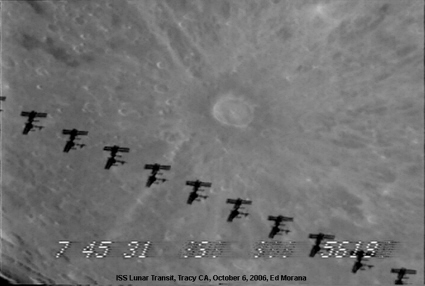
The silhuette of the International Space Station (ISS) crossing the Moon is is clearly visible in this composite image by astroimager Ed Morana. He captured this view near Tracy, California using a 10-inch Meade LX200GPS telescope, Watec 902H CCD video camera, and other equipment. Copyright 2006, Ed Morana. Used with permission.
(OCT 3) LOS ANGELES - Griffith Observatory officially reopens its doors to the public Friday, November 3, 2006, after completing a comprehensive and ambitious $93 million renovation and expansion project, it was announced today by Antonio R. Villaraigosa, Mayor of the City of Los Angeles. More
(OCT 3) BERKELEY, CA - George F. Smoot, 61, leader of a research team that was able to image the infant universe, revealing a pattern of miniscule temperature variations which evolved into the universe we see today, has been awarded the 2006 Nobel Prize for physics. More
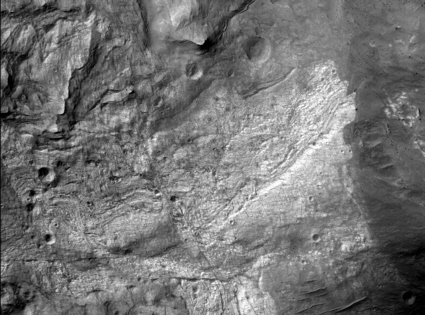
The High Resolution Imaging Science Experiment (HiRISE) camera on NASA's Mars Reconnaissance Orbiter captured this first image of Mars from the spacecraft's mapping orbit on September 29. This view shows a portion of Ius Chasma and demonstrates the instrument's resolution. HiRISE is operated by the University of Arizona and was built by Ball Aerospace and Technology Corp., Boulder, Colo. Image courtesy NASA/JPL/University of Arizona
(SEP 27) NASA's Mars Rover Opportunity has arrived at the rim of a crater approximately five times wider than a previous stadium-sized one it studied for half a year. More
(SEP 26) LOS ANGELES AIR FORCE BASE, Calif. -- Flames kissed the sky as the final two solid rocket motor upgrades, more commonly recognized as the two boosters on a Titan IV rocket, were destroyed recently. More
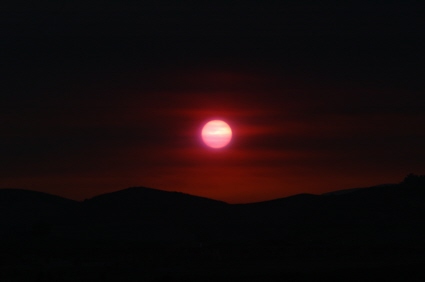
Despite the best efforts of firefighters, southern California's Day Fire has charred a path of destruction through the Los Padres National Forest for three weeks. In addition to fouling the air, the smoke from the blaze produced colorful sunsets, like this one photographed by the webmaster on September 11. Copyright 2006, Brian Webb
(SEP 23) The inaugural launch from New Mexico's Spaceport America is scheduled for Monday, September 25.
A SpaceLoft XL rocket is slated to lift-off from Spaceport America in Upham, NM at 07:30 MDT and a make a brief suborbital flight to the edge of space. The single stage, solid fuel vehicle will carry human ashes and several student experiments to an altitude of 70 miles.
The 13-minute flight will end when the rocket lands at the U.S. Army's White Sands Missile Range 33 miles from the launch site.
(SEP 19) NASA's Mars Reconnaissance Orbiter has extended the long-armed antenna of its radar, preparing the instrument to begin probing for underground layers of Mars. More
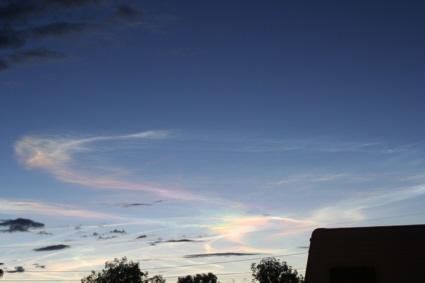
Sunlit missile exhaust paints the dawn sky following from Wednesday's aborted missile defense test at White Sands, New Mexico. The test was halted when the Hera target missile had to be destroyed by range safety. Chris Wagner took this image from Queen Creek, Arizona, some 300 miles away. Copyright 2006 Chris Wagner.
(SEP 14) SUNNYVALE, Calif., - The second of four pairs of massive solar arrays and a Solar Alpha Rotary Joint (SARJ), built by Lockheed Martin at its Space Systems facility in Sunnyvale, have been installed on the International Space Station by the crew of the space shuttle Atlantis. The two new solar arrays have been deployed and are generating electricity. More
(SEP 13) The Missile Defense Agency was unable to complete a planned flight test of the Terminal High Altitude Area Defense (THAAD) system today due to a target missile failure at White Sands Missile Range, New Mexico.
An anomaly occurred shortly after the target missile was launched at 4:30 a.m. Mountain Daylight Time (6:30 a.m. EDT). The Hera target missile was destroyed by range safety officers approximately two minutes after it was launched. The THAAD interceptor missile was not launched due to the target failure. Program officials will analyze telemetry data from the target missile to determine the cause of the anomaly. A decision on rescheduling the test will be made after the mission review is completed.
White Sands Missile Range news release

A plume from New Guinea's Manam Volcano casts a pall over the center of this Aqua satellite view recorded September 3. Also visible is a greenish-tan plume of river sediment (left) running into the Pacific Ocean. Aqua was launched aboard a Delta rocket from California in 2002. Image courtesy NASA and Jesse Allen, Earth Observatory
(SEP 9) This morning's missile defense test involving a dual missile launch from White Sands, New Mexico was cancelled due to technical problems. The test has been tentatively rescheduled for Wednesday morning, September 13, between 04:00 and 06:00 MDT (03:00-05:00 PDT/10:00-12:00 UTC).
(SEP 6) An international team of astronomers using a network of small automated telescopes have detected a Jupiter-Sized planet 500 light-years from Earth. The telescopes used in the discovery consist mainly of amateur-astronomy components and off-the-shelf lenses. More
(SEP 6) The U.S. Army announced today that a test of the Terminal High Altitude Area Defense (THAAD) system is scheduled for the morning of Saturday, September 9 from New Mexico's White Sands Missile Range (WSMR).
The test will involve the launch of a Hera target and a THAAD missile sometime between 04:00 and 06:00 MDT. If the exercise occurs during morning twilight, residents of New Mexico, west Texas, Arizona, and northern Mexico may see an interesting light show as the exhaust of one or both missiles is illuminated by sunlight at high altitude.
This fourth in a series of five tests planned at WSMR will be a fully integrated flight test of all THAAD components. THAAD is currently in its development phase and will be an element of the multi-layered Ballistic Missile Defense System (BMDS), managed by the Missile Defense Agency (MDA).
THAAD uses technologies developed in earlier MDA programs and during the THAAD Program Development and Risk Reduction Phase. It is the first weapon system with both endo- and exo-atmospheric capability developed specifically to defend against ballistic missiles. The THAAD element will provide upper-tier defense in the terminal segment of MDA's BMDS. The BMDS is capable of providing a layered defense for the U.S., deployed forces, friends and allies against ballistic missiles of all ranges in all phases of flight. The higher altitude and theater-wide protection offered by THAAD provides more protection of larger areas than lower-tier systems alone. THAAD is designed to defend against short, medium, and intermediate range ballistic missiles.
The THAAD Program is managed by the Missile Defense Agency in Washington, D.C., and executed by the THAAD Project Office in Huntsville, Ala. Lockheed Martin Corporation is the prime contractor.
For advice on photographing missile launches, go to www.spacearchive.info/vafbphoto.htm
Adapted from a White Sands Missile Range news release
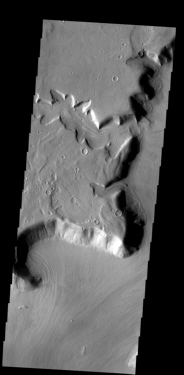
NASA's Mars Odyssey spacecraft recorded this image of an interesting tributary channel in Mars' Deuteronilus region. The view was taken with the spacecraft's Thermal Emission Imaging System (THEMIS), which was jointly developed by Arizona State University and Raytheon Santa Barbara Remote Sensing. Image courtesy NASA/JPL/Arizona State University.
(SEP 1) Vandenberg Air Force Base, Calif. - A Missile Defense Agency (MDA) interceptor missile successfully launched at 10:39 am PDT (1:39 pm EDT) from the Ronald W. Reagan Missile Defense Site, here. More
(AUG 31) This morning's launch of a ground-based anti-missile interceptor from Vandenberg AFB was postponed due to weather. The launch is part of an $85 million test of the U.S. Ground-based Midcourse Defense system.
The Missile Defense Agency planned to launch a missile carrying a mock warhead from Kodiak, Alaska followed by the interceptor from Vandenberg. However, weather conditions at Kodiak prevented launch of the target and the test was cancelled.
The MDA has rescheduled the test for tomorrow between 08:00 and 12:00 PDT.
(AUG 30) If the weather cooperates, an anti-missile interceptor is scheduled to lift-off from the Central Coast tomorrow morning from Vandenberg Air Force Base. Listen
Courtesy KCLU public radio
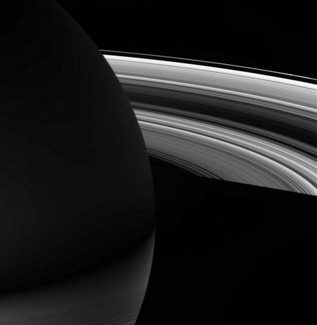
Saturn's night side and its majestic rings are suspended against the blackness of space in this recently released Cassini spacecraft image. The visible light view was recorded by Cassini's wide-angle camera at a distance of approximately 592,000 miles (952,000 kilometers) from the planet. The Jet Propulsion Laboratory in Pasadena, Calif. manages the Cassini mission for NASA. Image courtesy NASA/JPL/Space Science Institute
(AUG 25) Early risers have a chance to see a planetary close encounter this Saturday morning when Venus and Saturn will be separated by only 1/2 of a degree. To spot the pairing, go outside about 45 minutes before sunrise on August 26th and look for dazzling bright, white Venus low in the east. The much fainter Saturn will be just below Venus near the 7 o'clock position.
Although the pairing should easily be visible to the naked eye, you'll need an unobstructed eastern horizon. If you miss Saturday morning's pairing, don't despair. The two planets will also be quite close the next morning except that Saturn will be above and to the right of Venus.
(AUG 23) Supermassive black holes in some giant galaxies create such a hostile environment, they shut down the formation of new stars, according to NASA Galaxy Evolution Explorer findings published in the August 24 issue of Nature. More
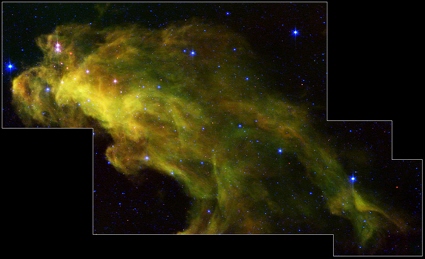
Infant stars appear as pink dots in this Spitzer Space Telescope image of the Witch Head Nebula, a gigantic murky cloud 800 light years away in the constellation Orion. The infrared view was obtained as part of a Spitzer Space research program involving high school teachers and their students from across the United States. The mission is managed by the Jet Propulsion Laboratory. Image courtesy NASA/JPL-Caltech
(AUG 19) The European Space Agency has issued a call for professional and amateur astronomers to participate in the SMART-1 impact observation campaign. The ESA spacecraft will end its lunar science mission by impacting the Moon's Sea of Excellence on the evening of September 2.
A spacecraft maneuver at the end of July will probably cause the impact to occur at one of the following times and locations:
| Date/Time (PDT) |
Date/Time (UTC) |
Latitude (° S) |
Longitude (° W) |
|---|---|---|---|
| SEP 2 17:36 | SEP 3 00:36 | 36.4 | 43.5 |
| SEP 2 22:41 | SEP 3 05:41 | 36.44 | 46.25 |
An exact time and place of impact is unavailable because of uncertainties regarding the Moon's topography.
According to SMART-1 project scientist Bernard Foing, if the plume from the impact reaches sunlight, it may be visible with an amateur telescope or binoculars.
For more information on the SMART-1 impact, go to the ESA web site.
(AUG 14) Mark Thiemens has spent an entire career studying and analyzing meteorites, chunks of space rock that survive the fiery plunge through Earth's atmosphere. Now he has an orbiting space rock-an asteroid or "minor planet"-to call his very own. More

Typhoon Saomai approaches the coast of China in this August 9 Aqua satellite image. Around the time this photo was taken, the typhoon had sustained winds of 150 miles (240 kilometers) per hour, a well-defined eye, and tightly wound spiral arms. Aqua was launched from California's Vandenberg AFB in 2002. Image Courtesy Jeff Schmaltz MODIS Land Rapid Response Team, NASA GSFC
(AUG 13) It begins with "The Red Planet is about to be spectacular!" and makes other claims including the Earth and Mars will soon have their closest approach in recorded history, that Mars will be the second brightest object in the night sky, and when viewed through a telescope at a magnification of 75 times, the Red Planet will appear to be as large as the full Moon does to the naked eye.
If you have an e-mail account, chances are you've recently received this recycled item that first made the rounds before our close pass by Mars in 2003. While it may have been true three years ago, it is now completely false.
There will be no close encounter between the two planets this year. The Earth and Mars are now a great distance apart. Rather than being prominent in the night sky, Mars is difficult to find with the unaided eye due to its faintness and its location low in the west at dusk.
As for Mars appearing as a large disk when viewed through a telescope, that is also false. Even when using an excellent amateur telescope under good conditions, the planet would now probably be very tiny and resemble the head of a pin.
(AUG 10) For the past three years, astronomers at the California Institute of Technology's Palomar Observatory in Southern California have been using the High Performance Wireless Research and Education Network (HPWREN) as the data transfer cyberinfrastructure to further our understanding of the universe. More
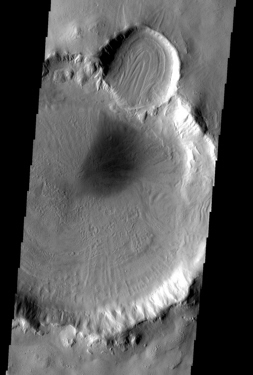
Patterns on the floors of martian craters are evident in this image taken by the THEMIS instrument onboard NASA's Mars Odyssey spacecraft. The patterns indicate that a volatile, such as ice, likely was present in the floor material. THEMIS is controlled and operated from the Arizona State University campus in Tempe, Arizona. Image courtesy NASA/JPL/Arizona State University.
(AUG 5) Next weekend the Orange County Astronomers will host AstroImage 2006, the premier astroimaging conference. Scheduled for August 11-12 at Brea, California's Curtis Theater, the event will bring astroimagers together to network and hear about the latest astrophotography techniques, software, and equipment.
The conference will include presentations by Chris Butler, Ron Dantowitz, Rob Gendler, Tony Hallas, John Laborde, Robert Reeves, Alan Smallbone, and Chuck Vaughn.
On Sunday, August 13, Scott Kardel will lead an optional "insiders" tour of the Palomar Observatory.
For more information on AstroImage 2006, go to www.ocastronomers.org/astroimage/2006.
(AUG 2) WAUKESHA, WI - For those who like to get up early, the first half of August offers great views of the solar system's most elusive naked-eye planet. Mercury climbs into view in the east-northeast during the first few days of the month, appearing as a pale-yellow dot low in the morning twilight. More
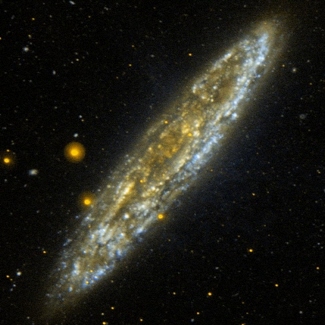
Located 10 million light-years away, the Silver Dollar galaxy (NGC 253), is one of the sky's brightest spiral galaxies. In this view from NASA's Galaxy Evolution Explorer (GALEX), the blue wisps are relatively dustless star forming areas while the golden glow represents regions where dust heavily obscures the far-ultraviolet. GALEX uses UV light to measure the history of star formation most of the way back to the Big Bang. The mission is controlled from JPL in Pasadena, California. Image courtesy of NASA, JPL, Caltech
(JUL 28) Radar images from NASA's Cassini spacecraft have revealed lakes on Saturn's moon Titan. The lakes are the first discovered on another world and are most likely the source of hydrocarbon smog in the frigid moon's atmosphere. More
(JUL 26) NASA announced today that it has signed a memorandum of understanding with AirLaunch LLC, Kirkland, Wash., to explore collaborations in space launch systems and payloads launched from aircraft. More

A network of river channels located atop Xanadu, a continent-sized region on Saturn's moon Titan, are visible in this recent Cassini spacecraft radar image. At Titan's chilly conditions, streams of methane and/or ethane might flow across parts of the region. The picture covers an area that is about 143 by 211 miles (230 by 340 kilometers) and shows features as small as 1,640 feet (500 meters). JPL in Pasadena, Calif. manages the Cassini mission for NASA's Science Mission Directorate. Image courtesy NASA/JPL
(JUL 20) VANDENBERG AIR FORCE BASE, Calif. - An unarmed Minuteman III intercontinental ballistic missile was launched from North Vandenberg today at 3:14 a.m. More
(JUL 19) This morning's Minuteman III launch from Vandenberg AFB was postponed 24 hours due to problems with air traffic control radars in the southwestern U.S. Liftoff is now slated for Thursday during a 01:01 to 07:01 PDT launch window.
The Air Force will probably try to launch the Minuteman at the very start of the window. However, unexpected technical and other issues could cause liftoff to occur at any time between 01:01 and 07:01.
(JUL 17) VANDENBERG AIR FORCE BASE, Calif. - An unarmed Minuteman III intercontinental ballistic missile is scheduled to launch from North Vandenberg Wednesday morning as an operational test to demonstrate the weapon system's reliability and accuracy. The six-hour launch window is from 1:01 to 7:01 a.m. PDT.
The missile will launch under the direction of the 576th Flight Test Squadron here.
Col. John Raymond, 30th Operations Group commander, is the spacelift commander or final "go-for-launch" authority.
Members of the 576th FLTS here installed tracking, telemetry and command destruct systems on the missile to collect data and meet safety requirements.
The missile's three unarmed re-entry vehicles are expected to travel approximately 4,200 miles, hitting a pre-determined water target in the Marshall Islands.
This joint operation combines Air Force and Army range tracking and weather surveillance.
The entire ICBM community, including the Department of Defense and the Department of Energy will use the data collected from this mission.
U.S. Air Force news release
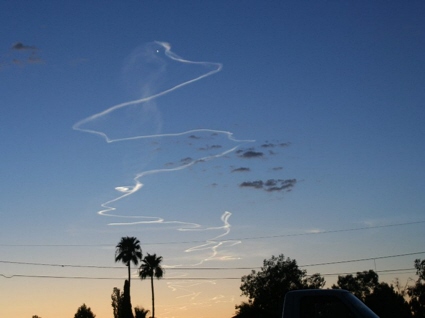
Chris Wagner of Queen Creek, Arizona snapped this photo of an interesting trail he unexpectedly saw last Wednesday morning (July 12). The image shows the sunlit exhaust from a missile defense test at White Sands Missile Range some 300 miles away. A Hera target missile was launched and successfully intercepted at high altitude by a Terminal High Altitude Air Defense (THAAD) missile. Copyright 2006, Chris Wagner. Used with permission.
(JUL 14) Oceanside, CA -- Some of the biggest names in the astronomy community will gather here this month for the second annual Southern California Astronomy Exposition hosted by Oceanside Photo and Telescope (OPT). More
(JUL 13) EL SEGUNDO, Calif., -- Raytheon Company has won an initial $38 million contract from the Global Positioning System (GPS) Joint Program Office at the U.S. Air Force Space and Missile Systems Center to design next-generation global positioning receivers. More
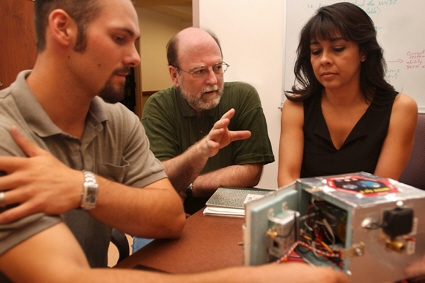
New Mexico State University professor Stephen Horan, center, works with students Jeremy Bruggemann, left, and Michelle Chavez to develop a test instrument that will eventually be launched into space. A rocket is slated to carry a NMSU payload to a height of 70 miles above New Mexico on August 14th. NMSU photo by Ben La Marca
(JUL 5) For the first time, NASA scientists using space-based measurements have directly monitored and measured the complete cycle of water movement for an entire continent. More
(JUL 5) Salt Lake City -- The Willard L. Eccles Foundation donated $600,000 so the University of Utah can build a 32-inch, research-class, optical telescope in southern Utah. More
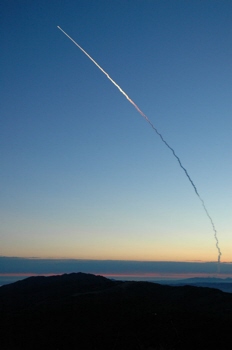
Boeing's Delta IV rocket begins its first-ever flight from the West Coast. The booster lifted-off from Vandenberg AFB after sunset on June 27 and placed a classified payload into orbit for the National Reconnaissance Office. Image Copyright 2006, Brian Lockett. Used with permission.
(JUN 30) Hartford, CT -- UP Aerospace, Inc. -- www.upaerospace.com -- the world's premier supplier of low-cost space access, has announced August 14th as the official date of the inaugural commercial space launch from New Mexico's proposed spaceport facility. More
(JUN 27) A new generation of rockets is set to make its West Coast debut this evening when it carries a secret cargo into orbit for a little-known U.S. spy agency. Listen
Courtesy KCLU public radio
(JUN 27) As of 04:45 this morning, this evening's Delta IV rocket launch from Vandenberg AFB appears to be on schedule.
The official L-1 weather forecast issued Monday morning predicted the following conditions at Vandenberg at launch time:
Clouds:
| Clouds | Coverage | Bases (ft) | Tops (ft) |
|---|---|---|---|
| Stratus | 8/8ths | 200 | 1,700 |
| Altocumulus | 6/8ths | 16,000 | 23,000 |
| Cirrus | 5/8ths | 25,000 | 33,000 |
Visibility: 1/2 nautical mile
Weather: Fog
Probability of violation of launch weather constraints: 30%
The above forecast calls for weather that will probably be within acceptable limits for launch. However, the situation for launch viewing probably won't be as favorable due to fog on the ground and cloud layers at different altitudes.
Weather conditions can change in a matter of hours. For the latest weather forecasts for the region, go to:
www.wrh.noaa.gov/lox/forecast.php
ifps.wrh.noaa.gov/cgi-bin/dwf?siteID=LOX

A large portion of the Middle East stretching from the green Nile Delta (left) to Saudi Arabia (lower right) is visible in this recent image from the MODIS instrument on NASA's Terra spacecraft. Terra was launched from California's Vandenberg AFB in 1999. Image courtesy of the MODIS Rapid Response Project
(JUN 23) ST. LOUIS - The first launch of a Boeing Delta IV rocket from the West Coast is set for June 27, from Vandenberg Air Force Base (VAFB), Calif. A Delta IV Medium+ (4,2) configuration launch vehicle is scheduled for liftoff from Space Launch Complex 6, between 7 and 9 p.m. Pacific time to deploy a satellite for the National Reconnaissance Office (NRO), NROL-22. The launch is the first West Coast mission for the U.S. Air Force Evolved Expendable Launch Vehicle (EELV) program.
Updated information throughout the mission will be available on the Boeing Launch Hotline at (714) 896-4770.
Boeing will broadcast the launch throughout the continental United States at:
Satellite: AMC 1, Transponder C17
Orbital Location: 103 Degrees West
Downlink Frequency: 4040 MHz Horizontal
Audio Channels: 6.2 and 6.8
For a Boeing media kit with mission information and a Web cast of the launch, go to:
www.boeing.com/defense-space/space/delta/media.htm
From a Boeing Media Advisory
(JUN 19) EDWARDS AIR FORCE BASE, Calif. - A C-17 Globemaster III performed the second in a series of tests June 14 by airdropping a 65-foot, 65,000-pound mockup of a booster rocket over Edwards Precision Impact Range Area. More
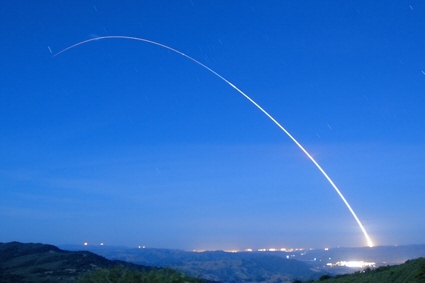
A Minuteman III ICBM arcs across the moonlit sky in this time exposure by Brian Lockett. The June 14 launch, called "Glory Trip 191 GM", sent three unarmed warheads from Vandenberg AFB to pre-determined targets in the Marshall Islands. Image Copyright 2006, Brian Lockett. Used with permission.
(JUN 14) VANDENBERG AIR FORCE BASE, Calif. - An unarmed Minuteman III intercontinental ballistic missile was launched from Launch Facility-04 on North Vandenberg at 1:22 a.m. today. More
(JUN 12) VANDENBERG AIR FORCE BASE, Calif. - An unarmed Minuteman III intercontinental ballistic missile is scheduled for launch from North Vandenberg Wednesday morning. The six-hour launch window is from 1:01 a.m. to 7:01 a.m. PST. The purpose of the launch is to verify the continued safety, reliability and accuracy of the Minuteman III ICBM.
The missile will launch under the direction of the 576th Flight Test Squadron here.
Col. Jack Weinstein, 30th Space Wing commander, is the spacelift commander. The mission director is Lt. Col. S.L. Davis, 576th FLTS commander. Members of the 576th FLTS installed tracking, telemetry and command destruct systems on the missile to collect data and meet safety requirements.
The missile's single unarmed re-entry vehicle is expected to travel approximately 4,200 miles in about 30 minutes, hitting a pre-determined target at the Kwajalein Missile Range in the western chain of the Marshall Islands. The nation's ICBMs are a key component of global stability - a safe, secure and affordable weapon system that delivers deterrence.
U.S. Air Force news release
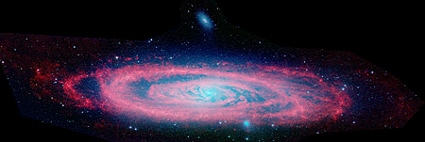
This infrared composite image from NASA's Spitzer Space Telescope shows M31, the Andromeda galaxy, a neighbor to our Milky Way galaxy. The image highlights the contrast between the galaxy's choppy waves of dust (red) and smooth sea of older stars (blue). JPL in Pasadena, Calif. manages the Spitzer mission for NASA. Image courtesy of NASA/JPL-Caltech/P. Barmby (Harvard-Smithsonian CfA)
(JUN 8) CubeSat, a collaboration between two California universities is about to perform the largest deployment ever of amateur radio satellites. The thirteen spacecraft are slated to ride into space aboard a Dnepr rocket launched from Kazakhstan. More
(JUN 1) VANDENBERG AIR FORCE BASE, Calif., -- A U.S. Navy missile telemetry tracking antenna developed by Lockheed Martin supported the U.S. Air Force's recent extended range flight test of a Minuteman III intercontinental ballistic missile, demonstrating its flexibility for a variety of missions. More
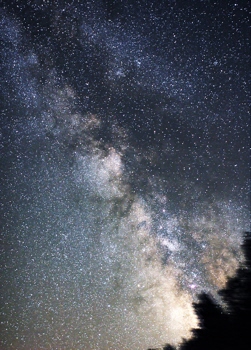
The summer Milky Way forms a river of stars in this image by Ginger Mayfield taken from Divide, Colorado. Mayfield combined four 60-second digital photos taken at f/2.8 and ISO 1600 and processed them to create this view. Copyright 2006, Ginger Mayfield
(JUN 1) PASADENA, Calif.--The detailed design for the Thirty Meter Telescope (TMT) developed by a U.S.-Canadian team is capable of delivering on the full promise of its enormous light-collecting area, according to the findings of an independent panel of experts. More
(MAY 25) SANTA CRUZ, CA -- Enceladus, a small icy moon of Saturn, may have dramatically reoriented relative to its axis of rotation, rolling over to put an area of low density at the moon's south pole. More
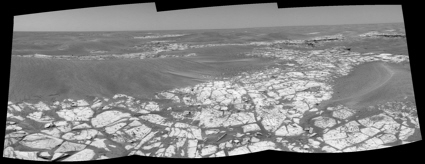
This mosaic from the Opportunity Mars rover looks toward the southeast in the direction of Victoria Crater. The rover's navigation camera took the images on the rover's 817th Martian day (May 12). Opportunity was preparing to deploy its robot arm instrument suite to analyze a rock on the outcrop pavement. Image courtesy NASA/JPL-Caltech/Cornell
(MAY 24) NASA's earth-observing satellites may protect thousands of people from floods and landslides by providing disaster monitoring and warning. The remote sensing spacecraft include polar orbiting payloads launched from California. More
(MAY 22) Compact jets that shoot matter into space in a continuous stream at near the speed of light have long been assumed to be a unique feature of black holes. But these odd features of the universe may be more common than once thought. More
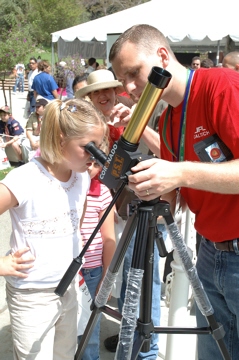
A future astronomer gets a close-up view of the Sun on Saturday during open house at the Jet Propulsion Laboratory. Solar observing was one of numerous attractions offered to the public during the May 20-21 event. Copyright 2006, Brian Webb
(MAY 18) NASA has chosen the RS-68 engine to power the core stage of the agency's vehicle intended to carry large payloads to the moon. The prime contractor for the engine is Pratt & Whitney Rocketdyne of Canoga Park, Calif. More
(MAY 15) BERKELEY, CA -- A team of astronomers has published the largest
three-dimensional map of the universe ever constructed. The wedge-shaped slice
of the cosmos extends 5.6 billion light-years deep into space, equivalent to
40 percent of the way back in time to the Big Bang. More
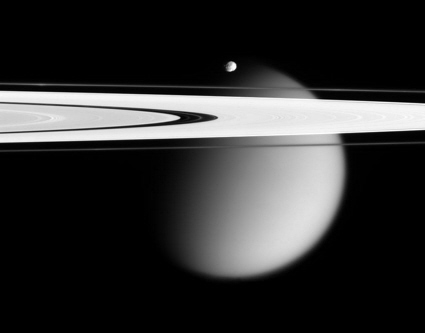
This vista from the Cassini spacecraft shows Saturn's moons Epimetheus and Titan and the planet's A and F rings. Tiny Epimetheus and hazy Titan are 72 miles (116 km) and 3,200 miles (5,150 km) across, respectively. Cassini took the image on April 28 at a distance of about 415,000 miles (667,000 km) from Epimetheus. JPL, a division of Cal Tech, manages the Cassini mission for NASA. Image courtesy of JPL/NASA
(MAY 10) ST. LOUIS -- The U.S. Air Force has awarded Boeing [NYSE: BA] Intercontinental Ballistic Missile (ICBM) Systems a $25.2 million contract to support the Minuteman Force Development Evaluation flight test program at Vandenberg Air Force Base, Calif. The Minuteman ICBM is a three-stage, solid-fueled strategic missile.
The Boeing team will provide hardware for command destruct operations -- a system that destroys a launch vehicle when vehicle performance degrades enough to be a safety hazard -- and the transmission of missile data during flight tests. A Boeing-designed flight instrumentation wafer will enable the Air Force to obtain data to evaluate the missile's in-flight reliability and accuracy.
First deployed in the 1960s, there are now 500 Minuteman ICBMs deployed in the nation's arsenal.
"This contract is a tribute to the expertise of our more than 500 ICBM employees in Utah, California, Ohio and at the Air Force's ICBM field locations," said Dave Hicks, Boeing's Anaheim, Calif.-based ICBM program manager. "Our employees take great pride in supporting the Air Force by providing this flight test instrumentation wafer."
The contract calls for work to be completed by January 2010.
Boeing news release
(MAY 8) NASA's Jet Propulsion Laboratory in Pasadena, Calif., invites the public to "Explore New Worlds" without leaving Southern California. The laboratory will open its doors during its annual Open House on Saturday and Sunday, May 20 and 21, from 9 a.m. to 5 p.m. More
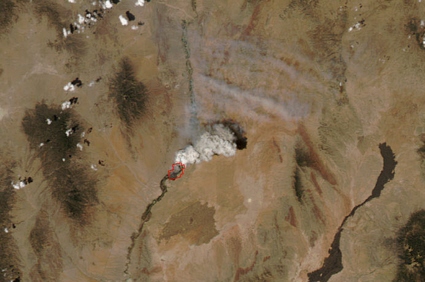
Smoke billows from a large fire just south of New Mexico's Bosque del Apache National Wildlife Refuge along the Rio Grande. This view was captured when the Moderate Resolution Imaging Spectroradiometer (MODIS) on NASA's Aqua satellite passed overhead on May 4. Aqua was launched from Vandenberg AFB in 2002. Image courtesy of NASA
(MAY 5) WAUKESHA, WI - If predictions hold, viewers could be in for a great nighttime show this month as the year's brightest comet passes close to Earth. Unfortunately, there are no guarantees - Comet 73P/Schwassmann-Wachmann 3 could just as easily fizzle out. More
(MAY 4) Astronomers will dedicate an array of 15 millimeter-wave radio telescopes tomorrow in California's Inyo Mountains. The Combined Array for Research in Millimeter-wave Astronomy, or CARMA should provide insight into the birth of galaxies, stars, planets, and the universe. More
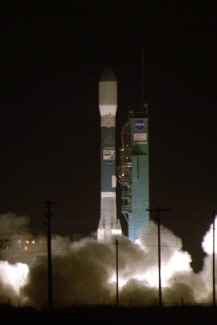
After several delays, a Delta II rocket lifts-off from Vandenberg AFB before dawn on April 28. The booster later successfully inserted the CloudSat and CALIPSO satellites into a polar orbit. According to one observer in Ventura County, the exhaust from the rocket's first stage was red-crimson in color and a star-burst pattern was visible at second stage ignition. U.S. Air Force photo by Brian Gavin.
(APR 28) ST. LOUIS -- A Boeing [NYSE: BA] Delta II rocket today successfully launched to orbit a pair of NASA satellites that will further study clouds and aerosols. More
(APR 26) The Air Force Space Command celebrated the 10th anniversary of the Midcourse Space Experiment satellite. Since its launch from Vandenberg AFB in 1996, MSX has supported space tracking operations and scientific research. More
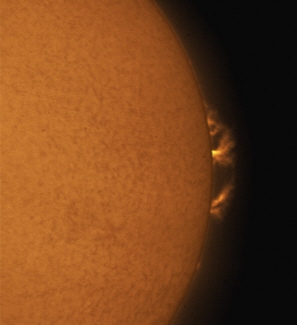
With solar activity nearing an 11-year minimum, this hydrogen light photo by Ginger Mayfield shows that the Sun is far from quiet. Mayfield imaged this eruption on the Sun's limb on April 22 at 12:11 PDT (19:11 UTC) from Divide, Colorado. Copyright 2006, Ginger Mayfield. Used with permission.
(APR 18) WAUKESHA, WI - The Lyrid meteor shower peaks the night of April 21/22. After midnight, as many as 20 meteors an hour will streak across the sky. The shower's radiant, the point in the sky where they appear to shoot from, lies in the constellation Lyra the Lyre. The waning crescent Moon will stay out of the way that night, so the sky will be dark - and the show should be good. For several nights before and after the peak, fewer meteors will be visible.
All you need to observe a meteor shower is your eyes - and a lawn chair if you don't want to strain your neck. Some people enjoy counting the number of meteors per hour, either by jotting down ticks on a notepad or talking into a tape recorder. Observing a meteor shower can be a great social event, so get some people together Friday night and make it a party.
Spring's warm weather makes the Lyrids the start of meteor-watching season. Watch for the Eta Aquarids later in the month. They'll be visible starting April 19, with a May 6 peak best seen from the Southern Hemisphere. This is one of two showers derived from Halley's Comet (the other is the Orionids in October).
Meteor showers occur when Earth passes through debris left by a passing comet or asteroid. For the Lyrids, the parent comet is C/1861 G1, whose debris enters our atmosphere at some 108,000 mph, a modest speed by meteor standards. Air friction incinerates the dust-size particles, creating the bright but brief flashes of light we see as meteors.
From an Astronomy Magazine news release
(APR 18) Vandenberg Air Force Base, Calif. - Team Vandenberg is set to launch a Boeing Delta II rocket, carrying NASA's Cloud-Aerosol Lidar and Infrared Pathfinder Satellite Observations and CloudSat satellites from Space Launch Complex-2 on North Vandenberg at 3:02 a.m. Friday.
The Delta II rocket will carry the CloudSat and CALIPSO satellites into a 438-mile circular sun-synchronous orbit.
Col. Jack Weinstein, 30th Space Wing commander, will be the spacelift commander for this mission.
Chuck Dovale is NASA's Launch Manager, for the mission.
The primary role of the 6,248-pound spacecraft is to gather information about the Earth's water cycle. Together, CALIPSO and CloudSat will provide new perspectives on Earth's clouds and aerosols, answering questions about how they form, evolve and affect water supply, climate, weather and air quality.
The Delta II is an expendable launch, medium-lift vehicle used to launch Navstar Global Positioning System satellites into orbit, providing navigational data to military users. Additionally, the Delta II launches civil and commercial payloads into low-earth, polar, geosynchronous transfer and stationary orbits.
Information courtesy U.S. Air Force
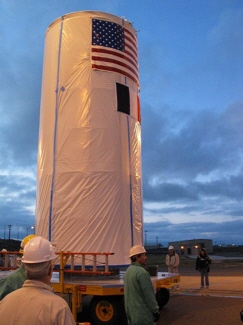
The CloudSat and CALIPSO spacecraft are transported from the Astrotech facility at Vandenberg AFB to the launch pad on April 8. The satellites are slated for lift-off next Friday aboard a Delta II rocket from Vandenberg's Space Launch Complex 2-West. Photo courtesy of Colorado State University
(APR 12) A globe-spanning constellation of six satellites expected to improve weather forecasts, monitor climate change, and enhance space weather research will head into orbit on Fri. April 14, 2006. Barring delays, a Minotaur rocket is scheduled to launch the array at 5:10 p.m. Pacific time from Vandenberg Air Force Base on the central Calif. coast. More
(APR 10) VANDENBERG AIR FORCE BASE, Calif. - Vandenberg AFB is set to launch a Minotaur rocket Friday from Space Launch Complex-8 on South Vandenberg. The launch period is from 5:10 to 8:10 p.m. The Minotaur will launch the COSMIC spacecraft, which consists of six low-earth orbiting, micro-satellites.
While in orbit, the satellites will form a constellation and collect data on atmospheric moisture.
30th Space Wing Commander Col. Jack Weinstein will be the spacelift commander, or final "go for launch" authority, for Friday's launch.
The Minotaur rocket is a ground-based variant of the Orbital Sciences Corp. air-launched Pegasus rocket. It is capable of launching up to 3,000 pounds into a low-Earth orbit and up to 800 pounds into geosynchronous transfer orbit.
Information courtesy U.S. Air Force
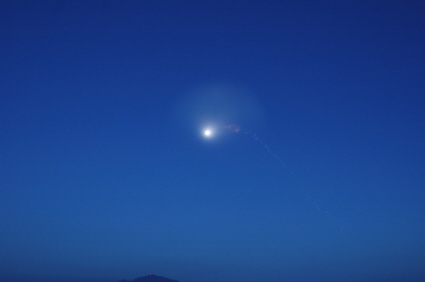
The April 7 dawn launch of Minuteman III ICBM from Vandenberg AFB creates a glowing orb in the skies above California. Two unplanned holds delayed the launch three hours until 06:00 PDT. The delays caused the missile's third stage exhaust to be lit by the Sun against the dawn sky. Copyright 2006, Brian Webb
(APR 5) NASA's Spitzer Space Telescope has uncovered new evidence that planets might rise up out of a dead star's ashes. The infrared telescope surveyed the scene around the remnant of an exploded star and found a surrounding disk made up of debris shot out during the star's death throes. More
(APR 5) VANDENBERG AIR FORCE BASE, Calif. - An unarmed Minuteman III intercontinental ballistic missile is scheduled to launch from North Vandenberg Friday morning as part of a developmental test to demonstrate the ability to the weapon system's effectiveness in a stressed environment on extended range. The six-hour launch window is from 3:01 a.m. to 9:01 a.m. PST.
The missile will launch under the direction of the 576th Flight Test Squadron here.
Col. Jack Weinstein, 30th Space Wing commander, is the spacelift commander.
Members of the 576th FLTS here installed tracking, telemetry and command destruct systems on the missile to collect data and meet safety requirements.
The missile's single unarmed re-entry vehicle is expected to travel approximately 5,100 miles, hitting a pre-determined water target near Guam in the northern Mariana Islands.
The joint operation combines Air Force, Navy and Army range tracking and weather surveillance.
"Our nation's ICBM force is a key component to global stability, and our Airmen are critical in Vandenberg's ongoing mission to verify, validate and enhance that capability," Colonel Weinstein said.
The entire ICBM community, including the Department of Defense and the Department of Energy will use the data collected through this mission.
Information courtesy U.S. Air Force

A hidden halo of smoky dust surrounding the galaxy M82 is revealed in this infrared view from the Spitzer Space Telescope. The dust particles (red) are being blown out into space by the galaxy's hot stars (blue). Spitzer also revealed that the dust has a carbon-containing compound. JPL manages the Spitzer mission for NASA. Science operations are conducted at the Spitzer Science Center at Caltech. Image courtesy of NASA/JPL-Caltech/C. Engelbracht (University of Arizona).
(MAR 31) CLEARFIELD, Utah - Northrop Grumman Corporation was awarded a $135 million dollar, six-year contract this week to begin the full-rate production phase of the Minuteman III Intercontinental Ballistic Missile (ICBM) Safety Enhanced Reentry Vehicle (SERV) program.
Under the SERV program, the Minuteman III missile will now carry single Mark 21 reentry vehicles, recently decommissioned from the Peacekeeper force, to ensure continued reliability and effectiveness of the ICBM weapon system. Lockheed Martin and Boeing are principal teammates on this program.
This award follows the third successful flight test of a SERV-modified Minuteman III conducted by the U.S. Air Force on Feb. 16. Along with earlier flight tests in July and August 2005, this latest test proved the successful integration of modified hardware and software into the existing Minuteman III weapon system.
The entire force of 500 Minuteman III missiles is slated to be upgraded with the SERV modifications by 2011.
Lockheed Martin Corporation, Bethesda, Md., developed the electronic and mechanical hardware that interfaces the reentry vehicle with the rest of the Minuteman III missile. Lockheed Martin's Valley Forge, Pa., facility produces the electrical and mechanical hardware, support equipment and associated logistics support.
The Boeing Company, Chicago, Ill., is responsible for modifying flight software, replacing the guidance system and integrating it into the missile.
From a Northrop Grumman news release
(MAR 29) The National Science Foundation recently awarded a three-year, $500,000 grant to New Mexico State University to refurbish and upgrade its 1-meter telescope. The souped-up result will have unmatched capabilities in high-speed photometry. More

Orbital Sciences Corporation successfully launched a Pegasus XL rocket at dawn on March 22 from a jumbo jet flying off California's Central Coast. The solid fuel rocket later inserted NASA's ST5 satellites into an elliptical polar orbit. Space enthusiast Jim Albers captured this image of the L-1011's contrail from Mountain View, California. Copyright 2006, Jim Albers. Used with permission.
(MAR 24) A cometary "string-of-pearls" flies past Earth in May closer than any comet in nearly 80 years. The largest fragments may glow bright enough to be faintly visible to the naked eye. More
(MAR 20) WAUKESHA, WI - The "morning star" Venus lights the sky before dawn, heralding spring's arrival. On March 25, the brilliant planet reaches its greatest western elongation - when the planet is as far west of the Sun as possible. Then, it sits just above the horizon in the east-southeast sky 2 hours before sunrise. Look for the waning crescent Moon passing to the right of the "morning star." Venus will be the bright object just to the upper left of the Moon.
Each day thereafter, Venus' sky position sinks closer to the horizon. Venus shone at its brightest, magnitude -4.6, in February, but the planet will dominate the morning sky throughout summer.
To the naked eye, Venus' light rivals only moonshine in the early morning sky. But you can use a telescope to watch as the planet changes phases, like the Moon's, during the year. By March 25, its globe measures 25" through a telescope and has fattened to half-lit. It's at its brightest for the year now; even though the phase increases, its angular size decreases as the Earth-Venus distance increases.
Our "sister planet" lies an average of 67 million miles (108 million kilometers) from the Sun. Because Venus lies closer to the Sun than Earth, it always appears close to our star in the sky.
On March 26, Venus and the Moon help you spot a rarely seen planet: Neptune. At about 5 a.m. local time, Venus appears slightly north of (above) Neptune. The Moon lies just below and to the left of the planets.
From an Astronomy magazine news release
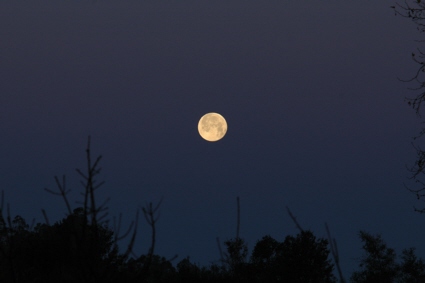
The full Moon descends over a distant hill as the approaching sunrise colors the sky a steel blue. The webmaster recorded this image at dawn on March 16 using his Nikon D70 digital SLR and 180mm Nikkor lens. Copyright 2006, Brian Webb
(MAR 15) NASA's Space Technology 5 spacecraft (ST5) launch was aborted today. A locking pin in the Orbital Science's Pegasus XL rocket's flight control service mechanism did not retract just prior to launch. Orbital Sciences and NASA engineers will diagnose and correct the problem.
A new launch date will be established pending resolution of the issue, the availability of the Western Range, and acceptable weather conditions at the Vandenberg Air Force Base, Calif. launch site. The delay will be at least 48 hours.
For information about the ST5 mission and NASA's New Millennium Program visit:
For information about NASA and agency programs on the Web, visit:
Information courtesy of NASA
(MAR 13) VANDEDBERG AFB, Calif. - The launch of an Orbital Sciences Corporation Pegasus XL rocket has been delayed due to weather restrictions. The launch has been rescheduled for Wednesday. The launch window extends from 5:57 to 7:19 a.m. The rocket, carrying NASA's Space Technology 5 spacecraft, will take off from an L-1011 aircraft, which will depart Vandenberg's runway before dropping its payload approximately 100 miles west-northwest of the base.
The spacelift commander for this mission is Col. Jack Weinstein, 30th Space Wing commander.
Information courtesy U.S. Air Force
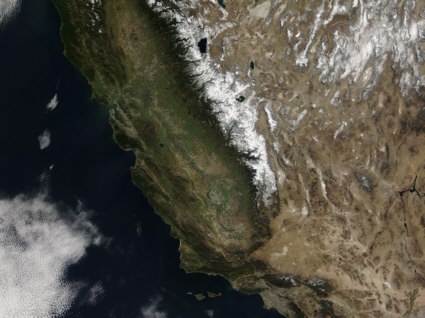
Numerous geographic features in California and Nevada are visible in this recent image from NASA's Terra satellite. The snow-capped Sierra Nevada mountains run down the center of this view. They are bounded by California's Central Valley to the left and Nevada's Great Basin to the right. Image courtesy Jeff Schmaltz MODIS Land Rapid Response Team, NASA GSFC
(MAR 12) A Pegasus rocket carrying a trio of NASA satellites is scheduled for launch from a jumbo jet early this Tuesday. An L-1011 will ferry the Pegasus XL from Vandenberg AFB to a drop point high above the Pacific west-southwest of Monterey, California.
The rocket is slated for release at 06:02 PST on March 14 during a launch window that extends from 05:57:21 to 07:19:50 PST. After a brief free fall, the Pegasus' first stage rocket motor will ignite and the vehicle will begin to climb. If all goes well, the rocket will insert the Space Technology (ST5) payload into a 186 by 2,796 mile polar orbit.
Once in orbit, ST5 will deploy three micro-satellites. The mission will validate innovative technology to reduce risks to future science missions. It will also demonstrate the ability of small satellites to perform research-quality science by taking measurements of Earth's magnetic field using highly sensitive magnetometers.
Assuming a launch early in the window, a weak visual display may be in store for coastal southern California as sunlight illuminates the rocket's exhaust plume during morning twilight. Since daylight Pegasus launches are very difficult to see, Tuesday's event may not be visible to observers located inland due to the sky brightness from the approaching sunrise. The optimum viewing location will likely be western Santa Barbara County.
NASA has scheduled the following programming in connection with this mission:
- Sunday, March 12, 13:00 PST: NASA TV airs live prelaunch news conference from Vandenberg.
- Sunday, March 12, 16:00 PST: NASA Direct, the Kennedy Space Center Internet broadcasting network, prelaunch webcast from Vandenberg. It will include interviews with representatives from NASA's Goddard Space Flight Center and the Jet Propulsion Laboratory. Experts will also take part in a question-and-answer session discussing the goals, science, and technology involved in the mission.
- Tuesday, March 14, 04:30 PST: Kennedy's Virtual Launch Control Center provides launch day coverage featuring real-time countdown milestone updates, streaming video clips highlighting mission preparation, and launch activities.
To view ST5 launch and mission coverage on the Web, visit www.nasa.gov/st5.
NASA TV's Public, Education and Media channels are available on an MPEG-2 digital C-band signal accessed via satellite AMC-6, at 72 degrees west longitude, transponder 17C, 4040 MHz, vertical polarization. In Alaska and Hawaii, they are on AMC-7 at 137 degrees west longitude, transponder 18C, at 4060 MHz, horizontal polarization. For digital downlink information, visit www.nasa.gov/ntv.
NASA TV is reportedly also available on Dish TV channel 213 and Direct TV channel 376.
From Air Force and NASA news releases and other sources
(MAR 6) BOULDER - The next sunspot cycle will be 30-50% stronger than the last one and begin as much as a year late, according to a breakthrough forecast using a computer model of solar dynamics developed by scientists at the National Center for Atmospheric Research (NCAR). More
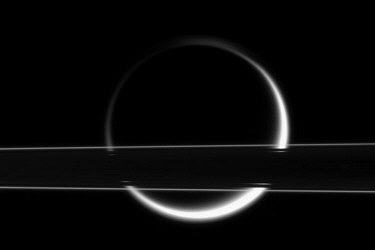
The smoggy atmosphere of Saturn's moon Titan glows brilliantly in scattered sunlight, creating a thin, gleaming crescent in this Cassini spacecraft image. At this angle above the ring plane, the thin F ring shines brightly. Light from Titan's eastern and western limbs (edges) penetrates the Cassini Division, which looks like a thin gap from this angle. JPL, a division of the California Institute of Technology in Pasadena, manages the mission for NASA. Image courtesy NASA/JPL/Space Science Institute
Live coverage of the arrival at Mars originates from NASA's Jet Propulsion Laboratory, Pasadena, Calif., on NASA TV and the Web.
Live arrival and orbit insertion commentary airs on NASA TV and the Web on March 10 beginning at 12:30 p.m. PST. The orbiter's main engines begin firing shortly after 1:24 PST to slow it enough for Martian gravity to grab it into orbit. Commentary ends at approximately 2:45 p.m. PST.
News briefings from JPL will be carried on the Web and NASA TV (all times PST and subject to change):
Wednesday, March 8:
-- 10 a.m. PST, mission overview news briefing
Friday, March 10:
-- 9 a.m. PST, pre-arrival news briefing
-- 4:30 p.m. PST, post-arrival news briefing
Mission information, including a press kit, news releases, status reports, briefing schedule, videos and images, is available on the Web at:
For information about NASA and agency programs on the Web, visit:
NASA TV is carried on the Web and on an MPEG-2 digital signal accessed via satellite AMC-6, at 72 degrees west longitude, transponder 17C, 4040 MHz, vertical polarization. It's available in Alaska and Hawaii on AMC-7 at 137 degrees west longitude, transponder 18C, at 4060 MHz, horizontal polarization. The schedule for mission coverage is on the Web at:
http://www.nasa.gov/multimedia/nasatv/MM_NTV_Breaking.html
Adapted from a NASA media advisory
Using a recent upgrade to its Aegis weapons system, Hopper was tasked with detecting and tracking a Minuteman III Inter-Continental Ballistic Missile (ICBM) launched from Vandenberg Air Force Base, Calif. during the boost and initial ballistic portions of flight and providing cueing data to SPAWAR Space Systems Center (SSC) in San Diego and the Joint National Test Center in Colorado Springs for analysis.
In a role known as long range surveillance and track (LRS&T), Hopper has the capability to detect and track ICBMs and report track data to shore-based components of the missile defense system.
It can further provide fire control data to the ground-based ICBM interceptors located at Fort Greely, Alaska and Vandenberg Air Force Base.
At-sea tracking events, such as "Sky Hunter," have verified the capability of surface ships to track ICBMs and demonstrated the reliability of transmitting track data necessary to support missile defense situational awareness, target cueing and engagements.
Hopper has participated in three successful BMD missions. "Sky Hunter" and "Glory Trip-189" tracked ICBMs launched from Vandenberg.
During "Stellar Valkyrie" in November, Hopper provided cueing and track data on a medium range ballistic missile, which USS Lake Erie (CG 70) acquired and engaged with the newest variant of Standard Missile (SM-3).
Hopper's technicians are excited by the new mission area and the opportunity to flex their system.
"We get invaluable training and technical support from civilian Aegis experts during these missions," said Fire Controlman 2nd class James Wickham.
"I have learned a lot about our system - its capabilities and the future of BMD," said Wickham.
Thirteen Aegis destroyers are currently equipped with the LRS&T capability.
Information courtesy USS Hopper
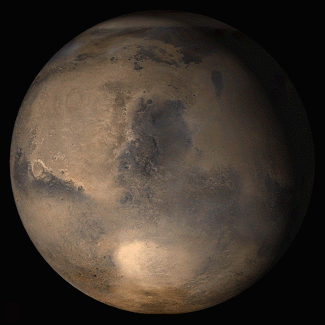
This view from NASA's Mars Global Surveyor (MGS) is actually a composite of Mars Orbiter Camera (MOC) daily global images acquired during a martian year. The dark area near the center is Syrtis Major, a feature easily seen in amateur telescopes. Malin Space Science Systems of San Diego operates and processes data from the MOC under contract to NASA. Image courtesy of NASA/JPL/Malin Space Science Systems
(FEB 24) NASA's Mars Reconnaissance Orbiter is nearing a crucial milestone. The spacecraft is preparing to slow itself to allow the red planet's gravity to grab it into orbit on March 10. More
(FEB 21) SAN BERNARDINO, Calif. - Feb. 21, 2006 -- Securing the future of Northrop Grumman Corporation operations in San Bernardino, the company cut the ribbon today on its newly-constructed Missile Engineering Center, located on Hospitality Lane near the junction of Interstates 10 and 215.
Northrop Grumman's presence in San Bernardino spans more than 43 years of critical support to our nation's defense. With more than 230 scientists, engineers and other professionals in the area, the company occupies 85,000 sq. feet in this new three-story location known as Brier Corporate Center.
The Missile Engineering Center serves as a vital proving ground for missile technology development and provides support to several key government missile programs. The center's flagship programs include the ICBM Minuteman III modernization program where Northrop Grumman is the prime contractor responsible for maintaining, sustaining and modernizing the nation's fleet of Minuteman III missiles; and the Kinetic Energy Interceptor program -- a critical boost/ascent or midcourse-phase missile defense program where Northrop Grumman is the prime contractor developing and testing this capability.
Northrop Grumman came to San Bernardino in 1962 when the former TRW Inc. moved into the area from Los Angeles. The company co-located with its customer at Norton Air Force Base to work on the Titan missile and the Minuteman II missile programs. When Norton was closed in 1994, the company temporarily moved off the base while offices were being refurbished by the Inland Valley Development Agency. In February 1996, Northrop Grumman returned to become the first major tenant in the redeveloped former Air Force base.
Adapted from a Lockheed Martin news release
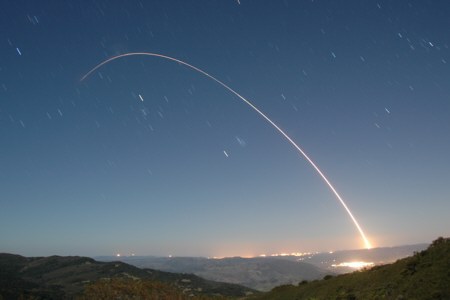
A Minuteman III traces an arc across the moonlit sky just after midnight on Thursday in this time exposure by Brian Lockett. The missile lifted-off from Vandenberg AFB and sent an unarmed warhead 4,800 miles downrange to its target in the central Pacific. Copyright 2006, Brian Lockett.
(FEB 17) WAUKESHA, WI - The best time to see Mercury this year is right now. Mercury will brighten as an evening “star” in the western sky until it reaches greatest eastern elongation - when the planet is as far east of the Sun as it can get. The evening of February 23 should provide the best view of Mercury as it shines at -0.5 magnitude, which makes it the second brightest object in the evening sky after the star Sirius.
Not only does Mercury appear bright in the sky at greatest elongation, but the closest planet to the Sun also rises to its highest point in the sky. At greatest elongation, Mercury reaches a maximum of 18° above the horizon February 23 and 24. [For comparison, your closed fist held at arm's length spans 10°.] After February 24, the planet dims nightly. On March 1, it glows at magnitude 0.3.
Mercury orbits the Sun at an average distance of only 36 million miles (58 million kilometers). Earth is nearly 3 times as far, so, from our perspective, Mercury always stays near the Sun.
When Mercury is west of the Sun, we view it as a morning star in the east before sunrise. Some elongations are better than others because of Earth's tilt and the stretched-out nature of Mercury's orbit. Even at its farthest from the Sun, Mercury appears no more than 28° away from the star.
Through a telescope, observers will watch Mercury go through phases similar to the Moon's. On February 8, the planet's disk was more than 90-percent illuminated. At greatest elongation, Mercury's disk will appear half-lit, and it will shrink to a 23-percent-illuminated crescent by March 1.
Most observers detect no surface markings on Mercury. It takes a seasoned observer and excellent atmospheric conditions to see anything at all on the planet, even through the largest amateur telescopes. Experienced amateurs, however, have recorded dusky markings and occasional bright areas on the planet.
Adapted from an Astronomy Magazine news release
(FEB 16) VANDENBERG AIR FORCE BASE, Calif. - An unarmed Minuteman III intercontinental ballistic missile was launched from Launch Facility-10 on North Vandenberg at 12:01 a.m. Thursday. More
(FEB 14) VANDENBERG AIR FORCE BASE, Calif. - An unarmed Minuteman III intercontinental ballistic missile is scheduled to launch from North Vandenberg Thursday morning as part of a developmental test to demonstrate the ability to integrate modified products into weapons systems. The six-hour launch window is from 12:01 a.m. to 6:01 a.m. PST.
The missile will launch under the direction of the 576th Flight Test Squadron here.
Col. Jack Weinstein, 30th Space Wing commander, is the spacelift commander. The mission director is Lt. Col. Stephen Davis, 576th FLTS commander. Members of the 576th FLTS here installed tracking, telemetry and command destruct systems on the missile to collect data and meet safety requirements.
The missile's single unarmed re-entry vehicle is expected to travel approximately 4,800 miles in about 30 minutes, hitting a pre-determined target at the Kwajalein Missile Range in the western chain of the Marshall Islands. The nation’s ICBMs are a key component of global stability - a safe, secure and affordable weapon system that delivers deterrence.
Information courtesy U.S. Air Force
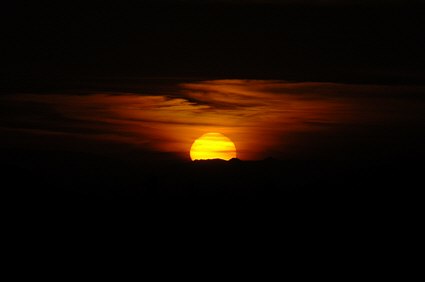
The sun sets behind California's Channel Islands on a recent winter evening. The daily change in setting Sun's position and the terrain make this view possible for only a few evenings twice per year. Copyright 2006, Brian Webb
(FEB 9) A NASA rocket bearing a payload built at Montana State University blasted 175 miles into space shortly before noon Wednesday, Feb. 8, above New Mexico's White Sands Missile Range. More
(FEB 6) Astronomers using the Sloan Digital Sky Survey (SDSS) telescope at Apache Point Observatory spent three months last fall scanning the sky for supernovae - exploding stars in distant galaxies - and the hunting was good. More

A thick plume of smog from China (left) makes its way across the Yellow Sea towards Korea. Skies over China have darkened in the past five decades, thanks to a nine-fold increase in fossil-fuel emissions. The MODIS instrument on NASA's Aqua spacecraft took this image on January 27. Aqua was launched aboard a Delta II rocket from Vandenberg AFB in 2002. Image courtesy of Jeff Schmaltz, MODIS Land Rapid Response Team, NASA GSFC
(FEB 3) Chances are you have noticed the faint, close grouping of stars known as the Pleiades glittering in the winter sky. This Sunday night-Monday morning (February 5-6), the first quarter Moon passes through the Pleiades for observers on the West Coast and Hawaii.
Using a small telescope or binoculars, skywatchers can watch the Moon eclipse (or, as astronomers call it, "occult" from Latin "to hide") members of the star cluster. Whether the Moon occults a given star, as well as the disappearance and reappearance times, varies depending on location.
From downtown Los Angeles, the stars Merope, Alcyone, Atlas, and Pleione disappear at 00:16, 00:56, 01:30, and 01:36 PST (08:16, 08:56, 09:30, and 09:36 UTC), respectively. The reappearances of Merope and Alcyone will be difficult to see due to the Moon's low elevation and because they emerge on the Moon's daylight side. Pleione and Atlas reappear after moonset.
For the disappearance and reappearance times of the brightest Pleiades for other cities, use the following links:
www.lunar-occultations.com/iota/2006plnam/0206zc537.htm
www.lunar-occultations.com/iota/2006plnam/0206zc552.htm
www.lunar-occultations.com/iota/2006plnam/0206zc560.htm
www.lunar-occultations.com/iota/2006plnam/0206zc561.htm
Of particular interest is the gazing occultation of Electra. The Moon will barely occult or graze the star within an extremely narrow zone that runs through southern California. Suitably equipped observers within the path may be able to alternately see the star disappear behind mountains and shine through valleys on the Moon's north pole.
Occultation enthusiasts have identified northern Somis, California as a prime location for observing the graze. The narrow path also passes over Thousand Oaks, part of Los Angeles, and northern Orange County, as well as other locations from south of Santa Maria to the southern Imperial Valley.
Detailed maps, information about a planned expedition to northeastern Orange County, and other information is available at iota.jhuapl.edu/plds6feb.htm.
(FEB 1) The world's meteorites are vanishing and could be gone in a lifetime. To preserve these scientific treasures, a University of Arizona scientist and private collector have formed the UA Southwest Meteorite Center. More
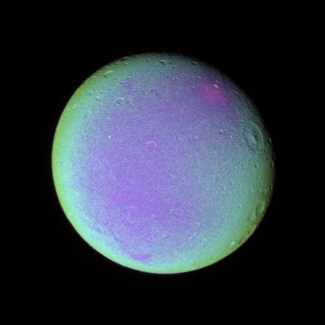
This recently released false color Cassini image reveals subtle differences in the leading hemisphere of Saturn's moon Dione. The reason for the color variations is unknown, but may be due to differences in surface composition or soil grain size. JPL manages the Cassini mission for NASA's Science Mission Directorate. Photo courtesy of NASA/JPL/Space Science Institute.
(JAN 26) The crew of the International Space Station will soon cast an empty space suit adrift to test a new concept. Signals from SuitSat should be audible on the ground using a simple police scanner or 2-meter ham radio gear. More
(JAN 23) Less sunlight reaching the Earth's surface has not translated into cooler temperatures, according to a team of solar physicists at New Jersey Institute of Technology (NJIT). More
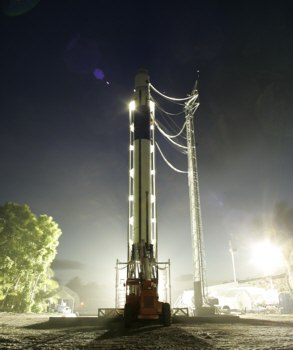
A Falcon I rocket stands on its pad at Omelek Island in the Central Pacific. California-based Space Development Corporation hopes to launch the vehicle next month. The launch will be the first-ever for the Falcon I series of low-cost rockets. Photo courtesy of Space Development Corp.
(JAN 18) VANDENBERG AIR FORCE BASE, Calif. - The 2006 launch schedule for Vandenberg is looking to be the busiest in six years, with twice the launches planned as last year, according to the 30th Space Wing Plans office. More
(JAN 17) When it comes to finding asteroids or comets that swing too close to home, the Catalina Sky Survey is currently Earth's best defense. More
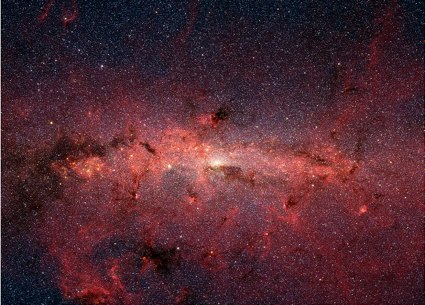
This dazzling infrared image from NASA's Spitzer Space Telescope shows hundreds of thousands of stars crowded into the swirling core of our spiral Milky Way galaxy. In visible-light pictures, this region cannot be seen at all because dust lying between Earth and the galactic center blocks our view. The Spitzer Space Telescope mission is managed by the Jet Propulsion Laboratory. Image courtesy of NASA/JPL-Caltech/S. Stolovy (SSC/Caltech)
(JAN 14) The endless dance of Jupiter's moons will treat observers to a dual shadow transit this Monday morning. On January 16 from 05:54 to 07:52 PST (13:54 to 15:45 UTC), Europa and Ganymede will cast ink-black shadows into the giant planet's atmosphere. The shadows and their movement across Jupiter's disk should be easily visible in telescopes with apertures as small as four or five inches.
(JAN 10) The Planetary Society, the founding sponsor of SETI@home, is again teaming with the University of California at Berkeley to engage the public in real science. The new project - Stardust@home - will allow internet users to help researchers search for microscopic interstellar dust particles captured by NASA's Stardust spacecraft, scheduled to return its fragile cargo to Earth on January 15, 2006. More
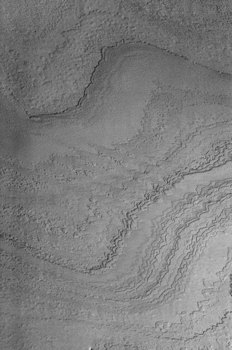
Layered terrain near Mars' south pole was captured in this view from NASA's Mars Odyssey spacecraft's THEMIS instrument. The image has a resolution of 52 feet (17 meters). Image courtesy of NASA/JPL/Arizona State University
(JAN 7) Observers on the West Coast have an opportunity to see a dual jovian moon transit this Monday. On January 9 from 06:33 to 07:45 PST (14:33 to 15:45 UTC), Jupiter's moons Europa and Ganymede will pass in front of the planet's disk. Assuming good conditions, the event should be visible before sunrise in a moderate-sized amateur telescope.
(JAN 5) AZUSA, Calif. - Northrop Grumman Corporation (has delivered the first Advanced Technology Microwave Sounder (ATMS) to the National Aeronautics and Space Administration (NASA) for early integration into a new spacecraft, for the NPOESS Preparatory Program (NPP), to be launched in early 2008 to monitor global environmental conditions. More
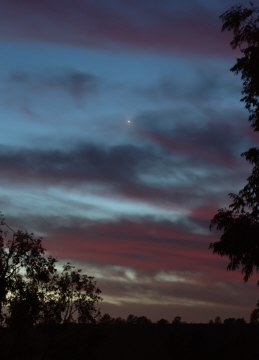
Venus shines between bands of clouds from an approaching storm Friday evening. The planet is currently making a rapid transition from the dawn to dusk sky, but the event is being obscured by extensive cloudcover from a pair of winter storms. Copyright 2005, Brian Webb
Copyright © 2006-2016, Brian Webb. All rights reserved.